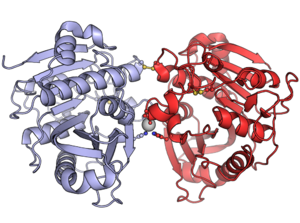Chlorophyllase facts for kids
Quick facts for kids Chlorophyllase |
|||||||||
|---|---|---|---|---|---|---|---|---|---|

|
|||||||||
| Identifiers | |||||||||
| EC no. | 3.1.1.14 | ||||||||
| CAS no. | 9025-96-1 | ||||||||
| Databases | |||||||||
| IntEnz | IntEnz view | ||||||||
| BRENDA | BRENDA entry | ||||||||
| ExPASy | NiceZyme view | ||||||||
| KEGG | KEGG entry | ||||||||
| MetaCyc | metabolic pathway | ||||||||
| PRIAM | profile | ||||||||
| PDB structures | RCSB PDB PDBe PDBsum | ||||||||
| Gene Ontology | AmiGO / QuickGO | ||||||||
|
|||||||||
| Chlorophyllase | |||||||||
|---|---|---|---|---|---|---|---|---|---|
| Identifiers | |||||||||
| Symbol | Chlorophyllase | ||||||||
| Pfam | PF07224 | ||||||||
| Pfam clan | CL0028 | ||||||||
| InterPro | IPR017395 | ||||||||
|
|||||||||
Chlorophyllase is a special helper molecule, called an enzyme, found in plants. It plays a very important role in how plants handle chlorophyll. Chlorophyll is the green stuff that helps plants make their own food using sunlight.
This enzyme is often called chlase for short. It helps break down chlorophyll into two smaller parts: chlorophyllide and phytol. You can find chlorophyllase in different parts of plant cells, like the chloroplasts. These are the tiny factories where plants make food. Chlorophyllase works best when the temperature is around 50 °C and the pH is about 8.5.
Why do plants break down chlorophyll?
Chlorophyll is super important for plants to live and grow. So, plants carefully control when they make it and when they break it down. You can see chlorophyll breaking down when leaves change color in the autumn. This also happens when fruits ripen or when leaves get old.
Chlorophyllase starts this process. It helps plants get rid of their green color. This is important because old or broken chlorophyll can actually harm the plant cells. By breaking it down quickly, plants protect themselves from damage. It's like cleaning up old toys to make space for new ones.
How chlorophyllase works
Chlorophyllase works by breaking a chemical bond in the chlorophyll molecule. Imagine chlorophyll as a long chain. Chlorophyllase acts like a tiny pair of scissors, cutting the chain. This cut separates chlorophyll into chlorophyllide and phytol.
Here's the simple reaction:
- chlorophyll + water = phytol + chlorophyllide
After chlorophyllide is made, other enzymes continue the breakdown process. This eventually leads to the plant losing its green color. For example, chlorophyllide is changed into something called Pheophorbide a. Then, another enzyme breaks open a ring-like structure in Pheophorbide a. This causes the plant to turn yellow or brown.
How chlorophyllase is controlled
The activity of chlorophyllase can be controlled by different things.
- Other molecules: The product of the reaction, chlorophyllide, can actually slow down chlorophyllase. This is a way for the plant to make sure not too much chlorophyll is broken down at once. Some fats in the plant can also affect it.
- Temperature: Chlorophyllase works best at certain temperatures. For example, chlorophyllase from wheat plants works well between 25 and 75 °C. If it gets too hot (above 85 °C), it stops working.
- Plant hormones: A plant hormone called ethylene can make plants produce more chlorophyllase. This is why ethylene is sometimes used to help fruits ripen and lose their green color faster. Ethylene tells the plant to start making more of the chlorophyllase enzyme.
Scientists are still learning exactly how chlorophyllase is controlled in plants. This research helps us understand how plants manage their green color throughout their lives.
Template:Esterases

